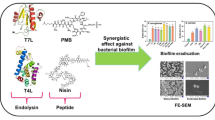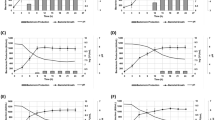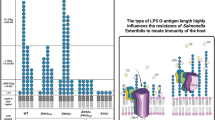Abstract
In spite of scientific evidence demonstrating the antiviral activity of lactic-acids bacteria, little is known about the mechanism of their action. Previously, several bacteriocins isolated from lactic acid bacteria (LAB) and some other microorganisms were reported as having antiviral activity in vitro. In the present study, chemically synthetized enterocin B (EntB) and the strain E. faecium L3, known as the producer of this peptide, were tested for activity against influenza viruses. The inhibition of cytopathic effect of А/Perth/16/2009(H3N2) and A/South Africa/3626/2013(H1N1) pdm influenza viruses in MDCK cells by chemically synthetized EntB was revealed. The EntB demonstrated antiviral activity at a concentration of 2.5–5 μg/ml depending on the dose of viruses. This peptide exhibited low toxicity in MDCK cells, causing partial damage of the monolayer of the cells only at a concentration above 10 μg/ml. It was also shown, that strain E. faecium L3-protected mice from lethal A/South Africa/3626/2013(H1N1) pdm infection. We speculate that this protective effect of enterococci may be associated with the specific action of enterocin B, which possesses antiviral activity in vitro.




Similar content being viewed by others
References
Hill C, Guarner RG, Gibson GR, Merenstein DJ, Pot B, Morelli L, Canani RB, Flint HJ, Salminen S, Calder PC, Sanders ME (2014) Expert consensus document. The international scientific Association for Probiotics and Prebiotics consensus statement on the scope and appropriate use of the term probiotic. Nature Rev Gastroenterology Hepatology 11(8):506–514. https://doi.org/10.1038/nrgastro.2014.66. PMID 24912386
Quintana V, Torres N, Wachsman M, Sinko P, Castilla V, Chikindas M (2014) Antiherpes simplex virus type 2 activity of the antimicrobial peptide subtilosin. J Appl Microbiol 117:1253–1259. https://doi.org/10.1111/jam.12618
Salminen S (1998) Lactic acid bacteria: microbiology and functional aspects. 2 Ed. New York: Marcel Dekker Inc, pp. 14–22
Stoyanova LG, Ustyugova EA, Netrusov AI (2012) Antibacterial metabolites of lactic acid bacteria: Their diversity and properties. Prikl Biokhim Mikrobiol 48(3):259–275
Suvorov A (2013) Gut microbiota, probiotics, and human health. Biosci Microbiota. Food Health 32(3):81–91. https://doi.org/10.12938/bmfh.32.81
WHO. Influenza A (H1N1) Virus Resistance to Oseltamivir: 2008 Southern Hemisphere Influenza Season – 2008: http://www.who.int/csr/disease/influenza/oseltamivir_summary_south_2008/en/index.html
Al Kassaa I, Hober D, Hamze M, Chihib N, Drider D (2014) Antiviral potential of lactic acid bacteria and their bacteriocins. Probiotics Antimicrob Prot 6(3–4):177–185. https://doi.org/10.1007/s12602-014-9162-6
Drider D, Bendali F, Naghmouchi K, Chikindas M (2016) Bacteriocins: not only antibacterial agents. Probiotics Antimicrob Prot 8(4):177–182. https://doi.org/10.1007/s12602-016-9223-0016-9223-0
Wu S, Jiang Z, Sun Y, Yu B, Chen J, Dai C, Tang XL, Chen XY (2013) Microbiota regulates the TLR7 signaling pathway against respiratory tract influenza A virus infection. Curr Microbiol 67(4):414–422. https://doi.org/10.1007/s00284-013-0380-z
Ichinohe T, Pang I, Kumamoto Y, Peaper D, Ho J, Murray T, Iwasaki A (2011) Microbiota regulates immune defense against respiratory tract influenza A virus infection. Proc Natl Acad Sci 108(13):5354–5359. https://doi.org/10.1073/pnas.1019378108
Olaya Galán N, Ulloa Rubiano J, Velez Reyes F, Fernandez Duarte K, Salas Cárdenas S, Gutierrez Fernandez M (2016) In vitro antiviral activity of Lactobacillus casei and Bifidobacterium adolescentis against rotavirus infection monitored by NSP4 protein production. J Appl Microbiol 120(4):1041–1051. https://doi.org/10.1111/jam.13069
Hoffmann H, Schneider W, Blomen V, Scull M, Hovnanian A, Brummelkamp T, Rice C (2017) Diverse viruses require the calcium transporter SPCA1 for maturation and spread. Cell Host Microbe 22(4):460–470. https://doi.org/10.1016/j.chom.2017.09.002
Seumour J, Klebanoff S, Watts H, Mehlin C, Headley C (1999) Lactobacillus and vaginal host defense: activation of the Human Immunodeficiency Virus type 1 long terminal repeat, cytokine production, and NF-kB. J Inf Dis 179:653–660
Dembinski J, Hungnes O, Hauge A, Kristoffersen A, Haneberg B, Mjaaland S (2014) Hydrogen peroxide inactivation of influenza virus preserves antigenic structure and immunogenicity. J Virol Methods 207:232–223. https://doi.org/10.1016/j.jviromet.2014.07.003
Chikindas M, Weeks R, Drider D, Chistyakov V, Dicks L (2018) Functions and emerging applications of bacteriocins. Curr Opin Biotechnol 49:23–28. https://doi.org/10.1016/j.copbio.2017.07.011
Cotter PD, Hill C, Ross RP (2005) Bacteriocins: developing innate immunity for food. Nat Rev Microbiol 3:777–788. https://doi.org/10.1038/nrmicro1273
Wachsman M, Castilla V, de Ruiz HA, de Torres R, Sesma F, Coto C (2003) Enterocin CRL35 inhibits late stages of HSV-1 and HSV-2 replication in vitro. Antivir Res 58(1):17–24
Todorov S, Wachsman M, Knoetze H, Meincken M, Dicks L (2005) An antibacterial and antiviral peptide produced by Enterococcus mundtii ST4V isolated from soya beans. Int J Antimicrob Agents 25(6):508–513. https://doi.org/10.1016/j.ijantimicag.2005.02.005
Todorov S, Wachsman M, Tomé E, Dousset X, Destro M, Dicks L, Dicks LM, Franco BD, Vaz-Velho M, Drider D (2010) Characterisation of an antiviral pediocin-like bacteriocin produced by Enterococcus faecium. Food Microbiol 27(7):869–879. https://doi.org/10.1016/j.fm.2010.05.001
Quintana V, Torres N, Wachsman M, Sinko P, Castilla V, Chikindas M (2014) Antiherpes simplex virus type 2 activity of the antimicrobial peptide subtilosin. J Appl Microbiol 117(5):1253–1259. https://doi.org/10.1111/jam.12618
Choi H, Song J, Ahn Y, Baek S, Kwon D (2009) Antiviral activities of cell-free supernatants of yogurts metabolites against some RNA viruses. European Food Res Technol 228(6):945–950
Torres N, Sutyak N, Xu S, Li J, Huang Q, Sinko P, Wachsman M, Chikindas M (2013) Safety, formulation, and in vitro antiviral activity of the antimicrobial peptide subtilosin against herpes simplex virus type 1. Probiotics Antimicrob Prot 5:26–36. https://doi.org/10.1007/s12602-012-9123-x
Serkedjieva J, Danova S, Ivanova I (2000) Anti-influenza virus activity of a bacteriocin produced by Lactobacillus delbrueckii. Appl Biochem Biotechnol 88(1–3):285–298
Ermolenko E, Furaeva V, Isakov V, Ermolenko D, Suvorov A (2009) Inhibition of Herpes simplex virus type 1 reproduction by probiotic bacteria in vitro. Vopr Virusol 55(4):25–28
Chenoll E, Casinos B, Bataller E, Buesa J, Ramón D, Genovés S, Muñoz J (2016) Identification of a peptide produced by Bifidobacterium longum CECT 7210 with antirotaviral activity. Front Microbiol 7:655. https://doi.org/10.3389/fmicb.2016.00655
Casaus P, Nilsen T, Cintas L, Nes I, Hernández P, Holo H (1997) Enterocin B, a new bacteriocin from Enterococcus faecium T136 which can act synergistically with enterocin A. Microbiology 143(7):2287–2294. https://doi.org/10.1099/00221287-143-7-2287
Desheva Y, Ermolenko E, Colobov A, Rudenko L, Suvorov A (2016) Antiviral activity of the enterocins EntB and EntXb against Influenza virus in MDCK cell line. J Clin Gastroenterol 50:218–219
Ermolenko K, Colobov ZA, Kulyashova L, Desheva Y, Ermolenko E (2016) Antiviral activity of different probiotic strains in Vero cell line. J Clin Gastroenterol 50:200201
Karaseva A, Tsapieva A, Pachebat J, Suvorov A (2016) Draft genome sequence of probiotic Enterococcus faecium strain L-3. Genome Announc 4(1):e01622–e01615. https://doi.org/10.1128/genomeA.01622-15
Averina O, Ermolenko E, Ratushniy A, Tarasova E, Borschev Y, Leontieva G, Kramskaya T, Kotyleva M, Danilenko V, Suvorov A (2015) Influence of probiotics on cytokine production in the in vitro and in vivo systems. Medicinskaya Immunologia 17(5):443–454
Ermolenko E, Chernysh A, Martsinkovskaia I, Suvorov A (2007) Influence of probiotic enterococci on the growth of Streptococcus agalactiae. Zh Mikrobiol Epidemiol Immunobiol.;(5):73-77.(5):73–77
Reed L, Muench H (1938) A simple method of estimating fifty per cent endpoints 12. Am J Epidemiol 27(3):493–497
WHO (2017) Availiable at http://www.who.int/mediacentre/news/releases/2017/seasonalflu/en
Rekstin A, Isakova-Sivak I, Petukhova G, Korenkov D, Losev I, Smolonogina T, Rudenko L (2017) Immunogenicity and cross protection in mice afforded by pandemic H1N1 live attenuated influenza vaccine containing wild-type nucleoprotein. Biomed Res Int.
Maeda N, Nakamura R, Hirose Y, Murosaki S, Yamamoto Y, Kase T, Yoshikai Y (2009) Oral administration of heat-killed Lactobacillus plantarum L-137 enhances protection against influenza virus infection by stimulation of type I interferon production in mice. Int Immunopharmacol 9(9):1122–1125. https://doi.org/10.1016/j.intimp.2009.04.015
Zelaya H, Alvarez S, Kitazawa H, Villena J (2016) Respiratory antiviral immunity and immunobiotics: beneficial effects on inflammation-coagulation interaction during influenza virus infection. Front Immunol 23;7:633. doi:10.3389/fimmu.2016.00633. eCollection 2016
Waki N, Yajima N, Suganuma H, Buddle B, Luo D, Heiser A, Zheng T (2014) Oral administration of Lactobacillus brevis KB290 to mice alleviates clinical symptoms following influenza virus infection. Lett Appl Microbiol 58(1):87–93. https://doi.org/10.1111/lam.12160
Karaffová V, Csank T, Mudroňová D, Király J, Revajová V, Gancarčíková S, Levkut M (2017) Influence of Lactobacillus reuteri L26 Biocenol™ on immune response against porcine circovirus type 2 infection in germ-free mice. Benef microbes 8(3):367–378. https://doi.org/10.3920/BM2016.0114
Vershinin A, Kolodzhieva V, Ermolenko E, Grabovskaia K, Klimovich B, Suvorov A, Bondarenko V (2008) Genetic identification as method of detection of pathogenic and symbiotic strains of enterococci. Zh Mikrobiol Epidemiol Immunobiol 5:8387
Alvarez-Sieiro P, Montalbán-López M, Mu D, Kuipers OP (2016) Bacteriocins of lactic acid bacteria: extending the family. Appl Microbiol Biotechnol 100:2939–2951. https://doi.org/10.1007/s00253-016-7343-9
Funding
The study was supported by the Grant of the Russian Ministry of Education and Science (Federal Targeted Program) 14.616.21.0024 “Development of new antimicrobial preparations based on enterococcal bacteriocincins.”
Author information
Authors and Affiliations
Corresponding author
Ethics declarations
All experiments were performed in compliance with ethical requirements and were approved by the Ethics Committee of the Institute of Experimental Medicine, Saint Petersburg, Russia.
Conflict of Interest
The authors declare that they have no conflict of interest.
Rights and permissions
About this article
Cite this article
Ermolenko, E.I., Desheva, Y.A., Kolobov, A.A. et al. Anti–Influenza Activity of Enterocin B In vitro and Protective Effect of Bacteriocinogenic Enterococcal Probiotic Strain on Influenza Infection in Mouse Model. Probiotics & Antimicro. Prot. 11, 705–712 (2019). https://doi.org/10.1007/s12602-018-9457-0
Published:
Issue Date:
DOI: https://doi.org/10.1007/s12602-018-9457-0




